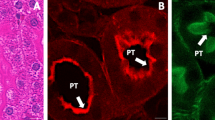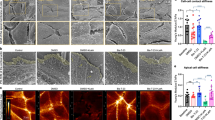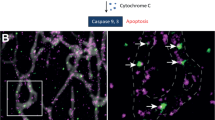Abstract
When proximal tubule epithelial cells are exposed to HgCl2, cytoplasmic blebs are formed. These represent on early, potentially reversible response to injury. These blebs are accompanied by reorganization of cytoskeletal proteins, and pre-sumably by alternations in cytoskeletal-plasma membrane interactions. Ca2+-activated proteinases, such as calpain, are known to affect cytoskeletal proteins and to be involved in diverse cellular processes. However, the role of calpains in cytotoxicity d due to HgCl2 is unknown. To determine the relationship between Factin, calpain, and HgCl2 toxicity, cells were stained with fluorescein phalloidin before and after treatment with HgCl2. Cells were grown on coverslips and exposed to HgCl2 (10 or 25 μM) in the presence or absence of the calpain inhibitor, leupeptin. Untreated cells were flat, polygonal, and contained many fluorescent-stained cables of actin filaments. Generally, cells exposed to HgCl2 became pleomorphic and contracted as the blebs formed. These cells showed fewer actin cables and fluorescence was seen mostly as either compact areas of dense stain or as peripheral rings. In many cells, actin cables and filaments were completely absent. Disappearance of F-actin was initially seen by 2 min after exposure to HgCl2. Thus, disruption of the actin cytoskeleton and blebbing were found to be early events in HgCl2 toxicity. When leupeptin was used with HgCl2 treatment, the actin staining appeared similar to that of untreated cells. These findings clearly illustrate that HgCl2 injury to proximal tubule epithelial cells causes rearrangement and alteration of F-actin which may involve the activation of calpain.
Similar content being viewed by others
Abbreviations
- HgCl2 :
-
mercuric chloride
- PTE:
-
proximal tubule epithelium
- [Ca2+]i :
-
cytosolic ionized calcium
- [Ca2+]e :
-
extracellular calcium
- PBS:
-
phosphate buffered saline
References
ANDERSON, E., SELIG, M., LEE, G.Y., and LITTLE, B. (1988). “An in vitro study of the effects of androgens on the cytoskeleton of ovarian granulosa cells with special reference to actin.” Tissue Cell 20: 855–874.
BALLATORI, N., SHI, C., and BOYER, J.L. (1988). “Altered plasma membrane ion permeability in mercury-induced cell injury: Studies in hepatocytes of elasmobranch Raja erinacea.” Toxicol. Appl. Pharmacol. 95:279–291.
BARAK, L.S., YOCUM, R.R., NOTHNAGEL, E.A., and WEBB, W.W. (1980). “Fluorescence staining of the actin cytoskeleton in living cells with 7-nitrobenz-2-oxa-1,3-dazole phalacidin.” Proc. Natl. Acad. Sci. USA 77:980–984.
BENGTSSON, T., RUNDQUIST, I., STENDAHL, O., WYMANN, M.P., and ANDERSSON, T. (1988). “Increased breakdown of phosphatidylinositol 4,5-biphosphate is not an initiating factor for actin assembly in human neutrophils. J. Biol. Chem. 263:17385–17389.
BROOKES, N. and YAROWSKY, P.J. (1985). “Determinants of deoxyglucose uptake in cultured astrocytes: The role of the sodium pump.” J. Neurochem. 44:473–479.
BROOKES, N. (1988). “Specificity and reversibility of the inhibition by HgCl2 of glutamate transport in astrocyte cultures.” J. Neurochem. 50:1117–1122.
CLARKSON, T.W. (1972). “The pharmacology of mercury compounds.” Ann. Rev. Pharmacol. 12:375–406.
COAKLEY, W.T. (1987). “Hyperthermia effects on the cytoskeleton and on cell morphology.” Symp. Soc. Exp. Biol. 41: 187–211.
CURTIS, D.R., DUGGAN, A.W., and JOHNSTON, G.A.R. (1970). “The inactivation of extracellularly administered amino acids in the feline spinal cord.” Exp. Brain Res. 10:447–462.
DIXON, S.J., PITARU, S., BHARGAVA, U., and AUBIN, J.E. (1987). “Membrane blebbing is associated with Ca2+-activated hyperpolarizations induced by serum and alpha 2-macroglobulin.” J. Cell Physiol. 132: 473–482.
ELLIGET, K.A., and TRUMP, B.F. (1991). “Primary cultures of normal rat kidney proximal tubule epithelial cells for studies of renal cell injury.” In Vitro Cell. Dev. Biol. (In press).
ELLIGET, K.A., PHELPS, P.C., and TRUMP, B.F. (1991). “Deregulation of cytosolic ionized calcium mediates sublethal and lethal HgCl2-induced injury in renal proximal tubular epithelium through calpain-mediated changes in cytoskeletal-membrane interactions.” (Submitted).
FOULKES, E.C. (1983). “Tubular sites of action of heavy metals, and the nature of their inhibition of amino acid reabsorption.” Fed. Proc. 42:2965–2968.
FOX, J.E.B. (1985). “Identification of actin-binding protein as the protein linking the membrane skeleton to glycoproteins on platelet plasma membranes.” J. Biol. Chem. 260:11970–11975.
FOX, J.E.B., REYNOLDS, C.C., MORROW, J.S., and PHILIPS, D.R. (1987). “Spectrin is associated with membrane-bound actin filaments in platelets and is hydrolysed by the Ca2+-dependent protease during platelet activation.” Blood 69:537–541.
GIPSON, I.K. and KEEZER, L. (1982). “Effects of cytochalasins and colchicine on the ultrastructure of migrating corneal epithelium.” Invest. Ophthalmol. Vis. Sci. 22:643–650.
GOLL, D.E., SHANNON, J.D., EDMUNDS, T., SATHE, S.K., KLEESE, W.C., and NAGAINIS, P.A. (1983). “Properties and regulation of the Ca2+-dependent proteinase.” In: Calcium-binding Proteins (B. de Bernard, G.I. Sottocassa, G. Sandri, E. Carafoli, A.N. Taylor, T.C. Vanaman and R.J.P. Williams, eds.). Elsevier Science Publishers, Amsterdam, New York, Oxford, pp. 19–35.
GRITZKA, T.L., and TRUMP, B.F. (1968). “Renal tubular lesions caused by mercuric chloride. Electron microscopic observations: Degeneration of the pars recta.” Am. J. Pathol. 52:1225–1277.
HEIZMANN, C.W. (1988). “Calcium-binding proteins of the EF-type.” J. Cardiovasc. Pharmacol. 12(suppl. 5): S30-S37.
HERMAN, I.M., CRISONA, N.J., and POLLARD, T.D. (1981). “Relation between cell activity and the distribution of cytoplasmic actin and myosin.” J. Cell Biol. 90:84–91.
JACKSON, P. and BELLETT, A.J.D. (1985). “Reduced microfilament organization in adenovirus type 5-infected rat embryo cells: A function of early region 1A.” J. Virol. 55:644–650.
JACKSON, P., and BELLETT, A.J.D. (1987). “The organization of vinculin and alpha-actinin in adenovirus 5-infected rat embryo cells. “Eur. Cell Biol. 44:161–165.
JACKSON, P. and BELLETT, A.J.D. (1989). “Relationship between organization of the actin cytoskeleton and the cell cycle in normal and adenovirus-infected rat cells.” J. Virol. 63:311–318.
JOHNSON, G.D. and DE C. NOGUEIRA ARAUJO, J.G.M. (1981). “A simple method of reducing the fading of immunofluorescence during microscopy.” J. Immunol. Methods 43:349–350.
KNAUF, R.A. and ROTHSTEIN, A. (1971). “Chemical modification of membranes. II. Permeation paths for sulfhydryl agents. “J. Gen. Physiol. 58:211–215.
KOIZUMI, T. and YAMANE, Y. (1988). “Protective effect of sodium molybdate on the acute toxicity of mercuric chloride. V. Enhancement of renal regeneration after exposure to HgCl2.” Chem. Biol. Interact. 67:185–197.
KOO, E.W., HAYES, M.A., WONG, M.K., and GOTLIEB, A.I. (1987). “Aflatoxin B1 and acteaminophen induce different cytoskeletal responses during prelethal hepatocyte injury.” Exp. Mol. Pathol. 47:37–47.
KORN, E.D. (1982). “Actin polymerization and its regulation by proteins from non muscle cells.” Physiol. Rev. 62: 673–737.
KRAMHOFT, B., LAMBERT, I.H., and PEDERSEN, R. (1989). “Mercuric chloride activates latent, anion-dependent cation transport systems in the plasma membrane of Ehrlich ascites tumor cells.” Pharmacol. Toxicol. 64:421–425.
LACHAPELLE, M. and ALDRICH, H.C. (1988). “Phalloidin-gold complexes: a new tool for ultrastructural localization of F-actin.” J. Histochem. Cytochem. 36:1197–1202.
LAIHO, K.U., BEREZESKY, I.K., and TRUMP, B.F. (1983). “Studies on the modification of the cellular response to injury: Effect of mannitol of Ehrlich ascites tumor cells following injury by anoxia or p-chloromercuribenzenesulfonic acid (PCMBS).” Exp. Mol. Pathol. 39:110–128.
LAZARIDES, E. and WEBER, K. (1974). “Actin antibody: The specific visualization of actin filaments in non-muscle cells.” Proc. Natl. Acad. Sci. USA 71:2268–2272.
MAGOUR, S., MASER, H., and GREIM, H. (1987). “The effect of mercury chloride and methyl mercury on brain microsomal Na+,K+-ATPase after partial delipidisation with Lubrol.” Pharmacol. Toxicol. 60:184–186.
MIRABELLI, F., SALIS, A., MARINONI, V., and FINARDI, G. (1988). “Menadione-induced bleb formation in hepatocytes is associated with the oxidation of thiol groups in actin.” Arch. Biochem. Biophys. 264:261–269.
OTTLINGER, M.E. and LIN, S. (1988). “Clostridium difficile toxin B induces reorganization of actin, vinculin, and talin in cultured cells.” Exp. Cell Res. 174:215–229.
PAINTER, R.G. and GINSBERG, M.H. (1984). “Centripetal myosin redistribution in thrombin-stimulated platelets. Relationship to platelet Factor 4 secretion.” Exp. Cell Res. 155(1):198–212.
PHELPS, P.C., SMITH, M.W., and TRUMP, B.F. (1989). “Cytosolic ionized calcium and bleb formation after acute cell injury of cultured rabbit renal tubule cells.” Lab. Invest. 60:630–642.
PITTS, R.F. (1963). Physiology of the kidney and body fluids: An introductory text. Year Book Medical Publishers, Inc., Chicago. pp. 202–214.
POLLARD, T.D. (1976). “Cytoskeletal functions of cytoplasmic contractile proteins.” J. Supramolecular Struct. 5: 317–334.
POLLARD, T.D. and COOPER, J.A. (1986). “Actin and actin-binding proteins. A critical evaluation of mechanisms and functions.” Ann. Rev. Biochm. 55:987–1035.
PRENTKI, M., CHAPPONIER, C., JEANRENAUD, B., and GABBIANI, G. (1979). “Actin microfilaments, cell shape and secretory processes in isolated rat hepatocytes.” J. Cell Biol. 81:592–607.
RUEGG, C., GANDOLFI, A.J., NAGLE, R.B., and BRENDEL, K. (1987). “Differential patterns of njury to the proximal tubule of renal cortical slices following in vitro exposure to mercuric chloride, potassium dichromate, or hypoxic conditions.” Toxicol. Appl. Pharmacol. 90:261–273.
SANGER, J.W. (1975). “Changing patterns of actin location during cell division.” Proc. Natl. Acad. Sci. USA 72: 1913–1916.
SANGER, J.W. and SANGER, J.M. (1980). “Banding and polarity of actin filaments in interphase and cleaving cells.” J. Cell Biol. 86:568–575.
SANGER, J.W., MITTAL, B., and SANGER, J.M. (1984). “Interaction of fluorescently-labeled contractile proteins with the cytoskeleton in cell models.” J. Cell Biol. 99:918–928.
SATO, T., McDOWELL, E.M., McNEIL, J.S., FLAMENBAUM, W., and TRUMP, B.F. (1977). “Studies on the pathophysiology of acute renal failure. III. A study of the juxtaglomerular apparatus of the rat nephron following administration of mercuric chloride.” Virchows Arch. [B] 24:279–293.
SCANLON, M., LASTER, S.M., WOOD, J.G., and GOODING, L.R. (1989). “Cytolysis by tumor necrosis factor is preceded by a rapid and specific dissolution of microfilaments.” Proc. Natl. Acad. Sci. USA 86:182–186.
SCHLIWA, M. (1981). “Proteins associated with cytoplasmic actin.” Cell 25:587–590.
SKYLAR, L.A., OMANN, G.M., and PAINTER, R.G. (1985). “Relationship of actin polymerization and depolymerization to light scattering in human neutrophils: Dependence on receptor occupancy and intra cellular Ca++. J. Cell Biol. 101:1161–1166.
SMITH, M.W., AMBUDKAR, I.S., PHELPS, P.C., REGEC, A.L., and TRUMP, B.F. (1987). “HgCl2-induced changes in cytosolic Ca2+ of cultured rabbit renal tubular cells.” Biochim. Biophys. Acta. 931:130–142.
SMITH, M.W., PHELPS, P.C., and TRUMP, B.F. (1991). “Cytosolic Ca2+ deregulation and 931:130–142. HgCl2 injury to cultured rabbit proximal tubule cells as determined by digital imaging microscopy.” PNAS 88:4926–4930.
SNYDER, E.L., HORNE, W.C., NAPYCHANK, P., Heinemann, F.S., and DUNN, B. (1989) “Calcium-dependent proteolysis of actin during storage of platelet concentrates.” Blood 73:1380–1385.
STOSSEL, T.P., CHAPONNIER, C., EZZEL, R.M., HARTWIG, J.H., JANMEY, P.A., KWIATKOWSKI, D.J., LIND, S.E., SMITH, D.B., SOUTHWICK, F.S., YIN, H.L., and ZANER, K.S. (1985). “Nonmuscle actin-binding proteins.” Ann. Rev. Cell Biol. 1:353–402.
TANG, X.J., LANCELLE, S.A., and HELPER, P.K. (1989). “Fluorescence microscopic localization of actin in pollen tubes-comparison of actin antibody and phalloidin staining.” Cell Motil. Cytoskeleton. 12:216–224.
TRUMP, B.F., BEREZESKY, I.K., SMITH, M.W., PHELPS, P.C., and ELLIGET, K.A. (1989). “The relationship between cellular ion deregulation and acute and chronic toxicity.” Toxicol. Appl. Pharmacol. 97:6–22.
TSUJINAKA, T., SAKON, M., KAMBAYASKI, J., and KOSAKI, G. (1982). “Cleavage of cytoskeletal proteins by two forms of Ca2+ activated neutral protease in human platelets.” Thromb. Res. 28:149–156.
VANDER, A.J. (1963). “Effects of zinc, cadmium, and mercury on renal transport systems.” Am. J. Physiol. 204: 781–786.
VANDERKERCKHOVE, J. (1990). “Actin-binding proteins.” Curr. Opin. Cell Biol. 2:41–50.
VERKLEIJ, A.J., and POST, J.A. (1987). “Physico-chemical properties and organization of lipids in membranes: their possible role in myocardial injury.” Basic Res. Cardiol. 82:85–91.
VIRTANEN, I. and MIETTINEN A. (1980). The role of actin in the surface integrity of cultured rat liver parenchymal cells. Cell Biol. Int. Rep. 1:29–36.
WEBB, W.W., BARAK, L.S., and TANK, D.W., and WU, E.S. (1981). “Molecular mobility on the cell surface.” Biochem. Sco. Symp. 46:191–205.
WEEDS, A. (1982). “Actin—binding proteins-regulators of cell architecture and mobility.” Nature 296:811–816.
WEINBERG, J.M., HARDING, P.G., and HUMES, H.D. (1983). “Alterations in renal cortex cation homeostasis during mercuric chloride and gentamicin nephrotoxocity.“ Exp. Mol. Pathol. 39:43–60.
WEINER, I.M., LEVY, R.I., and MUDGE, G.H. (1962). “Studies on mercurial diuresis: Renal excretion, acid stability and structure-activity relationship of organic mercurials.“ J. Pharmacol. Exp. Ther. 138:96–101.
WOLOSEWICK, J.J. and PORTER, K.R. (1979). “Microtrabecular lattice of the cytoplasmic ground substance: Artifact or reality.” J. Cell Biol. 82:114–139.
WU, E.S., TANK, D.W., and WEBB, W.W. (1982). “Unconstrained lateral diffusion of concanavalin A receptors on bulbous lymphocytes.” Proc. Natl. Acad. Sci. USA 16:4962–4966.
YAROWSKY, P., BOYNE, A.F., WIERWILLE, R., and BROOKES, N. (1986). “Effect of monensin on deoxyglucose uptake in cultured astrocytes: Energy metabolism is coupled to sodium entry.” J. Neurol Sci. 6:859–866.
YIN, H.L. and STOSSEL, T.P. (1979). “Control of cytoplasmic actin gel-sol transformation by gelsolin, a Ca2+-dependent regulatory protein.” Nature 281:583–586.
Author information
Authors and Affiliations
Additional information
Supported by Navy N00014-88-K-0427 & NIH DK15440. This is contribution No. 2905 from the Cellular Pathobiology Laboratory.
Rights and permissions
About this article
Cite this article
Elliget, K.A., Phelps, P.C. & Trump, B.F. HgCl2-induced alteration of actin filaments in cultured primary rat proximal tubule epithelial cells labelled with fluorescein phalloidin. Cell Biol Toxicol 7, 263–280 (1991). https://doi.org/10.1007/BF00250980
Received:
Accepted:
Issue Date:
DOI: https://doi.org/10.1007/BF00250980




